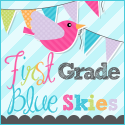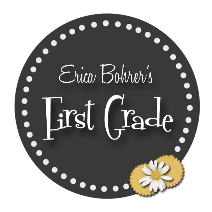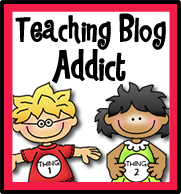Have you ever really wanted to do something and just kept putting it off?
Thank goodness for this glorious blogging community!
I was so excited when I saw a book study for Katie Wood Ray's, In Pictures and In Words, was in the works for this summer. There was my PUSH.
I have been meaning to read anything by Katie Wood Ray for a while now and just never got around to it. Reading and math are always in the way!
Writing instruction just doesn't seem to get as much screen time as those other two subjects. And it should have equal billing! Writing goes hand in hand with reading, for goodness sakes.
{And then, they wonder why so many teachers feel inadequate at teaching writing. Duh!}
On to the book at hand:
Katie Wood Ray is a breath of fresh air. In Pictures and In Words highlights the best practices of quality writing instruction for teachers. The first six chapters of the book explains why illustration study matters. The second section {chapters 7-11} will review fifty different illustration techniques for writing instruction.
Our wonderful host for the first section of the book, Deedee {Mrs. Wills Kindergarten} has written an excellent reflection of the book. I love the way she explains the chapters and includes examples from her own class. What a great way to bring the book to life!
For my contribution to the book study, I'll be answering the Guided Questions:
1. How might you explain to students that illustrating is composing?
I teach first grade at a Title 1 school. I'm lucky if 35% of my class can decode simple cvc words. I can guarantee that about 4-6 of my students will not know all of the alphabet. Getting them to illustrate during writing workshop has never been much of a problem because that's all they can do!
During our mini-lessons, I will make sure to elaborate on the fact that my students are authors, even if, all they can do in the beginning is illustrating. They are telling a story through pictures and soon they will be adding those words.
We'll work on those details in their illustrations. Whether its color choice or the amount of pictures on the page. Each part matters in their story telling. Then, we'll connect it to their words.
2. How might your attitude towards writing affect your students' willingness to write?
Sometimes I refer to myself as a salesperson and not an educator. I am selling them reading, writing, math, science, social studies, technology, etc.
Okay, there may be a few nonbelievers, but that's another reason why I love teaching first grade. I don't get as many apathetic students as I did in fourth grade.
I love to write. I always have. I bring in journals and letters from when I was a girl and share with the class. When I'm not conferencing with a student I'll spend some time writing and share my thoughts during share time.
We make HUGE deals about each other's writing when we share. They eat it up.
Last year, one of my students started writing a fairy tale of her own and her characters were kids from the class. Everyone laughed and pointed at each other. They were really funny. Then the next day, another child started a fairy tale as well. The third day, three more kids had written silly fairy tales. They all thought they were hysterically funny and they were writing. Oh, they were writing. The power of their words had created a wave of excitement throughout the room. It lasted about a week and a half and then it died off. But, it was exciting to see them inspire each other instead of me doing all of the work!
3. How might you help students build stamina in their writing?
This is actually going to be easy for me. I've been practicing the Daily 5 management system during my reading block for several years now and its ALL about building stamina for reading and writing.
We start small. Writing for 3 minute increments at a time and slowly build additional minutes every day until we reach our goal of 20-25 minutes of independent writing.
It is NOT as easy as it seems. Building stamina requires a lot of patience and perseverance, but it works. It works people!
We model, practice, check-in. Model, practice, check-in.
Hold strong and have faith. You'll break them!
I HIGHLY recommend reading the Daily 5.
4. What language might you use with your students when you talk about reading like a writer, both as a writer of words and pictures?
I really enjoyed this part of the book. Probably because I can relate to it so well.
As a blogger, I am always reading as a writer. I look at the blogs that I enjoy and think, "What is it about them that keeps me coming back? Is it humor, pictures, topics of interest?"
As a teacher, I will make sure to include the author and illustrators name often as I refer back to their books during lessons. Students will hear about the decisions the author and illustrators made and how it may apply to their words and illustrations. My language is important because I need to bring these authors and illustrators to life for my students. Bring value and a sense of urgency to their writing.
5. Name several books you would gather for your classroom's units of study on illustration.
I am going to have to get back to y'all on this one because I have a ton of great books in my classroom and I don't remember all of them. Sorry!
Okay, here are a few I can think of that I love off the top of my head:
*Maggie and the Pirate, Ezra Jack Keets

*I am the Dog, I am the Cat, Donald Hall

*Fortunately, Remy Charlip

I'll add to the list when I start going back to my classroom.
So far, I'm loving what I'm reading. Katie Wood Ray makes me feel good about myself and the choices I have made as an instructor. She puts developmentally appropriate practices ahead of all of the hustle and bustle administrators like to demand of us. AND she values conferring and sharing! Sharing time is so important to our littles.
If you'd like to read more about this book study, please go to Deedee's blog {here} and check out her post and the others linked up.
Thank you, Deedee!




















































































Great Post. I'm interested in the book Fortunately. Thank you for the recommendation!!
ReplyDeleteCheryl
Thank you for linking up! I love your book suggestions and I will add them to my list!
ReplyDeleteMrs. Wills Kindergarten